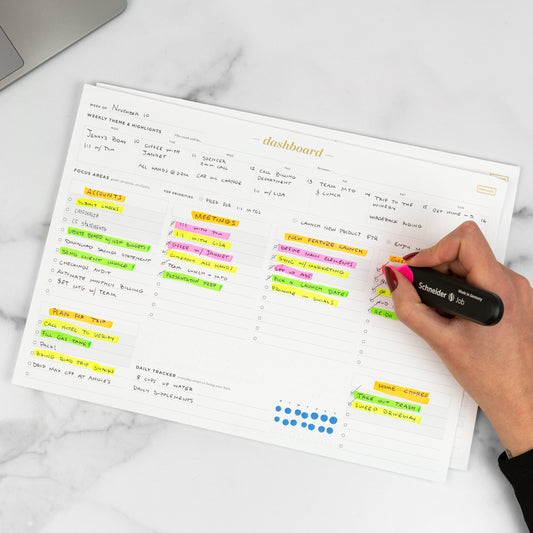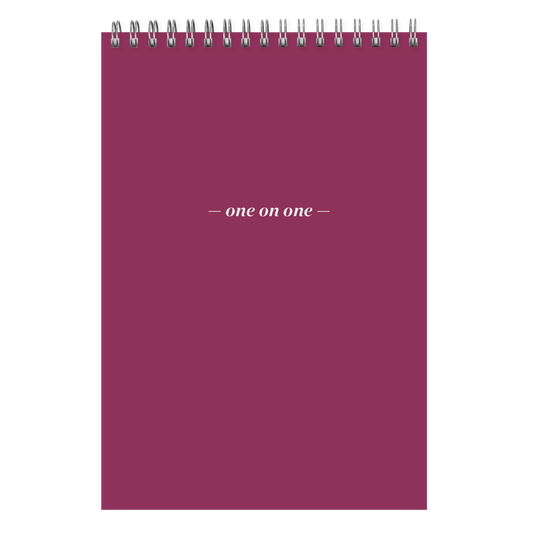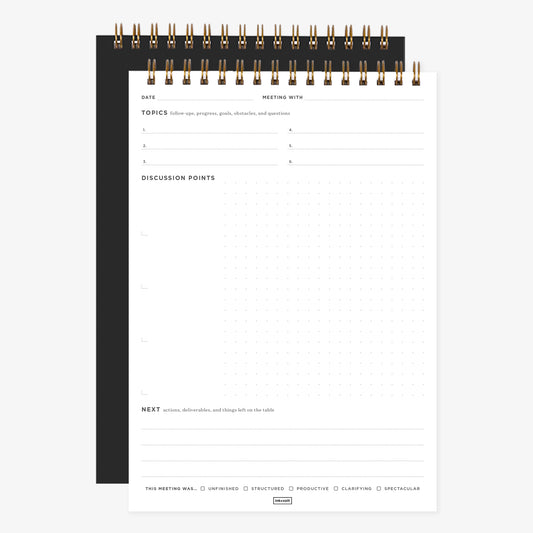If you’ve ever worked in an office, then you’re familiar with mid-year and end-of-year performance reviews.
While these twice-a-year check-ins might be fine for an office setting (where you’re usually serving the goals of a manager or company), you’ll probably want to check-in with your own goals on a more regular basis.
Rather than letting an entire year or several months pass by before figuring out what worked and what didn’t, it’s time to start reviewing your goals on a weekly basis instead.
Not only does a weekly planning session keep you more accountable, but it helps you identify the actions you need to take to move closer to your goals. Plus, we’re more likely to stick with our goals if we have a consistent routine in place and reward ourselves along the way.
Here are some ways that we can make progress on our big goals week by week.
Create a visual reminder
“Getting Things Done” writer David Allen has said that our heads make bad offices. In other words, we can’t rely on memory alone to keep track of all the things we want to do. If you want to stay organized and make progress on your goals, you need to take what's in your head and put it in writing.
Human beings are visual creatures, and if we see visual reminders of our goals, we’re more likely to act on them. There’s a reason why inspirational quotes and movies are such powerful motivators. When we see an underdog character overcome an obstacle or recite an inspiring mantra, it makes us feel like we also have the propensity to succeed.
One tool you can use to visualize your goals is the new Ink+Volt Weekly Desk Pad. We’ve taken the weekly spread in the Ink+Volt planner and turned it into a tear-off sheet. You can track your progress week by week and monitor your daily habits. And the best part? You don’t have to rely on your mind to sort through all your tasks and responsibilities -- you have it all on paper!
How to do a weekly planning session
You can make Sunday evenings your power night and use these sessions to take stock of the previous week and assess the week ahead.
I like to start by listing my achievements from the previous week -- it’s always more motivating and fun to start with the positive! You can put a star next to tasks that you’re most proud of. No task is too little to recognize. There have been weeks where the only things I’ve accomplished were laundry and dishes, but I still tried to recognize those small tasks. It’s a way of telling myself: “If I can accomplish these small actions, then I can build momentum in other areas as well.” I’m all about starting small!
Then I look at the tasks that I haven’t done. Here’s how I would add them to the new Ink+Volt Weekly Desk Pad:
1. Weekly goals: When looking at the tasks I need to do, I start by listing tasks that will serve my big, overarching goal for the year. Once those are in place, I look at the things I have to do to fulfill other people’s goals -- these are tasks my manager expects me to do, family obligations, etc. By starting with your own big goals, you make sure you will have space for them -- even if it’s just a little -- every single week.For instance, is your big goal to write a novel or run a marathon? Make sure to include actions that will get you closer to that goal. In this space, you can also include any personal/spiritual projects you’d like to maintain, like meditating or journaling. So in the space for weekly goals, you could write:
- Write 500 words each day on novel
- Meditate and journal 20 minutes each day
- Finish presentation for Friday conference
Utilize time blocking to make sure your schedule includes a few longer chunks of time dedicated to focused work. Trying to segment your day into too-small chunks will mean you don’t make significant progress on your most important work.
3. Daily tracker: In this space, you can write down the new habits that you’re trying to maintain. Productivity expert James Clear says that goals are great at providing direction, but it is your daily habits that actually help you achieve your goal.
If your goal is to write a novel, then this goal doesn’t really mean much if you don’t actually find the time to write. You need to start a daily habit to help you build momentum and stay consistent in meeting your goal.
If your goal is to write a novel, your daily habit can be “write 500 words every day.”
If your goal is to train for a marathon, your daily habit can be “run for 20 minutes.”
If your goal is to meditate, your daily habit can be “meditate for 5 minutes.”
If your goal is to increase your network, your daily habit can be “interact with at least one person I admire on social media each day.”
You can check off a box every time you complete your habit, which will motivate you to keep going and not break the chain.
4. Parking lot: Here is where you write down the projects, meetings, and activities that you want to save for later.Maybe a friend told you about a great book to read, or maybe you ran into someone that you’d like to meet for coffee sometime soon. You can write these items down in the parking lot so that you don’t forget them, but you also don’t have to deal with them right now. The parking lot items can help you identify your priorities for the coming weeks. Look at this section as you begin to plan out next week and beyond.
Your weekly planning session is a key to your success
This weekly planning session is a great way to honestly assess your schedule and see if you’re actually making movement towards your goals. If you notice that your schedule is mostly filled with social or work obligations, then you can adjust as necessary and try to make room in your week for your personal and professional goals.
At the end of the week, hold another planning session and see what you accomplished, what worked, and what needs adjusting. If you feel like you didn’t have a productive week, then ask yourself: what are things I can do next week to be more efficient? What happened that impacted my productivity this week?
A weekly planning session is an opportunity to reflect on your progress and re-charge for the week ahead. Because when it comes to achieving a big goal, it’s all about maintaining our energy and momentum for the long run, as well as breaking down our big goal into bite-sized pieces.
What are the small things you can do this week to move you closer to your goals?









